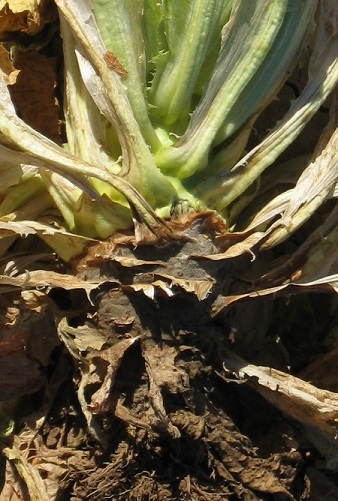
|
|
|
|

|
|||
|
|
|||
|
|
|||
|
Even though the end of our lettuce production season is fast approaching, Botrytis has been observed recently on romaine. The appearance of fuzzy gray growth at the base of maturing lettuce plants is a sign that the fungus Botrytis cinerea is present. The gray growth contains profuse amounts of spores, which are dispersed in the air. When favorable temperature and humidity levels exist, spores landing on senescent or damaged lettuce tissue will germinate, then grow into healthy plant leaf and stem tissue, which can lead to plant collapse and death. This outcome is similar to that caused by Sclerotinia minor and S. sclerotiorum, the causal agents of lettuce drop. Botrytis and Sclerotinia are related fungal pathogens, and fungicides effective against one are usually active against the other. As with Sclerotinia, fungicide applications for Botrytis management are most beneficial when plants are young and gray mold is not yet present. The value of applications later in the crop’s life has not been determined.
Click picture to listen to Mike's update
To contact Mike Matheron go to: matheron@ag.arizona.edu.
|
|||
| Back | |||
|
For questions or comments on any of the topics please contact Marco Pena at the Yuma Agricultural Center.
|
|||
|
Home |
Cotton | Veggies |
Forages | Grains
| Citrus |
Crop x Crop Insects | Diseases| Weeds | Pesticides | Economics | News | Weather | Research | Photos | Contacts | General Info. Copyright © 2001 University of Arizona, College of Agriculture and Life Sciences Webmaster: Al Fournier (acis@ag.arizona.edu) |
|||

